
Aponotoreas is a genus of moths in the family Geometridae erected by Robin C. Craw in 1986.

Pasiphila cotinaea is a species of moth in the family Geometridae. It is endemic to New Zealand. Its larvae feed off Olearia species and the adult moth can be seen on the wing from November to April. This species is regarded as rare.
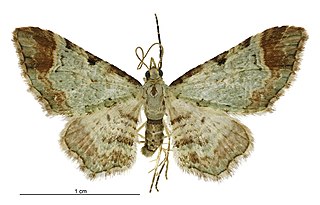
Pasiphila magnimaculata is a moth in the family Geometridae. It is endemic to New Zealand. The type locality of this species is Queenstown. It usually inhabits montane areas but has also been collected on Quail Island.

Epichorista aspistana is a species of moth of the family Tortricidae. It is endemic to New Zealand and has been collected in Canterbury and Otago. This species inhabits moist grassy areas at altitudes ranging from sea level to 1650m. Larvae feed on species within the genus Acaena. Adults are on the wing in November to February.
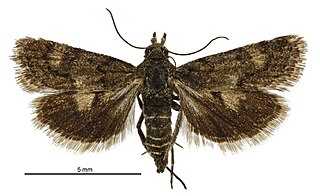
Heliothela atra is a moth of the family Crambidae. It was described by Arthur Gardiner Butler in 1877. This species is endemic in New Zealand and has been observed in both the North and South Islands. The preferred habitat of this species is dry tussock grasslands and short-sward sites. Adults of this species are on the wing from December until March and are day flying moths known for their rapid flight. This species is said to be associated with Melicytus alpinus.
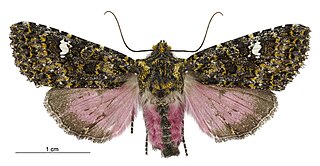
Meterana meyricci, also known as the rose underwing owlet, is a species of moth in the family Noctuidae. It was described and named by George Hampson in 1911 as Miselia meyricci. It is endemic to New Zealand and has been collected in and around Otago. The larvae of this species feed on Pimelea species, including Pimelea poppelwellii. Adults tend to found on the wing during the months of January to March.

Aponotoreas orphnaea is a moth of the family Geometridae. It is endemic to New Zealand.

Arctesthes catapyrrha is a moth of the family Geometridae. It is endemic to New Zealand.

Arctesthes siris is a moth of the family Geometridae. It is endemic to New Zealand.
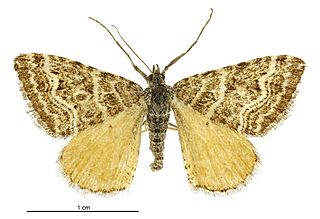
Xanthorhoe bulbulata is a species of moth in the family Geometridae. It is endemic to New Zealand. It is classified as critically endangered by the Department of Conservation.

Asaphodes chlamydota is a moth in the family Geometridae. It is endemic to New Zealand, and can be found in the lower part of the North Island and in the South Island. It inhabits native forest and shrublands. The larvae of this species feeds on native Clematis plants including Clematis afoliata. Adults are on the wing from November to April and are regarded as having intermedia flight powers.

Ichneutica cuneata is a moth in the family Noctuidae. It is endemic to New Zealand. I. cuneata is found in and around the Tongariro National Park in the North Island and throughout the South Island. Specimens found in Tongariro National Park tend to be darker in appearance than South Island specimens but as their colour is variable, and antennae and genitalia of both species are consistent, they are not now regarded as a separate species. I. cuneata inhabits tussock grasslands and shrublands in alpine and subalpine zones. The adults are on the wing from December to April and can be found flying during the day. The life history of I. cuneata is unknown as are the specific host species of its larvae. However larvae of I. cuneata are said to feed on herbaceous plants. The adults of this species also pollinate native species such as Myosotis macrantha.
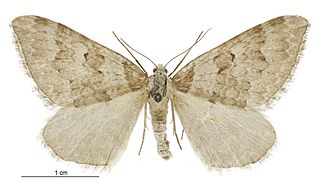
Xanthorhoe frigida is a species of moth in the family Geometridae. It is endemic to New Zealand. The larvae of this species feeds on species in the plant genus Pachycladon including the threatened Pachycladon wallii'. The adults of this species are on the wing from December to February. This moth is classified as nationally vulnerable by the Department of Conservation.

Notoreas chioneres is a species of moth in the family Geometridae. This species is endemic to New Zealand.

Asaphodes clarata is a species of moth in the family Geometridae. This species is endemic to New Zealand and has been found on the North and South Islands. The species inhabits open grassy areas, including tussock grasslands, in montane habitat. The larvae feed on the leaves of Ranunculus species. The adult moths are day flying and are on the wing from December to February and have been shown to pollinate Celmisia laricifolia and Hebe pinguifolia.

Asaphodes declarata is a species of moth in the family Geometridae. This species is endemic to New Zealand and has been observed in the southern parts of the South Island. This species prefers open tussock grassland habitat amounts beech forest and in mountainous terrain. It can be found at altitudes of between 450 and 1750 m. The adults of this species are on the wing from November to March. The moths can vary both in size and, with the female of the species, in markings.
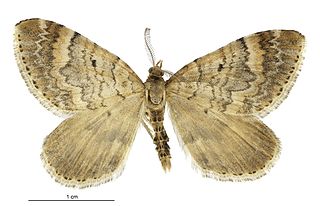
Asaphodes dionysias is a species of moth in the family Geometridae. This species is endemic to New Zealand and is only known from mountainous areas in Central Otago. It lives in open grassy mountainous habitat at altitudes up to 1750 m. It is also known to live in wetland habitat. The larvae of this species feed on native herbs. The adults of this species are on the wing in January and February. The adult female of the species has reduced wing size in comparison to the male.
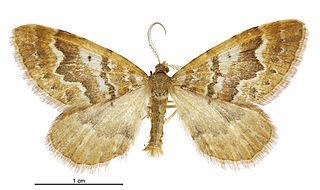
Asaphodes exoriens is a species of moth in the family Geometridae. This species is endemic to New Zealand and has been found in Central Otago. This is an alpine species and frequents open grassy habitat. They can also be found in upland wetland habitat at altitudes between 800 and 1100 m. Adults are on the wing in March.

Notoreas ischnocyma is a species of moth in the family Geometridae. This species is endemic to New Zealand. This species is found in Canterbury and Otago.
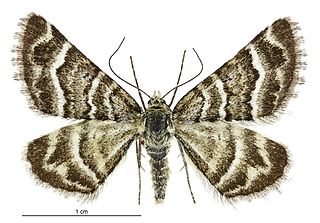
Notoreas paradelpha is a species of moth in the family Geometridae. It is endemic to New Zealand.





















